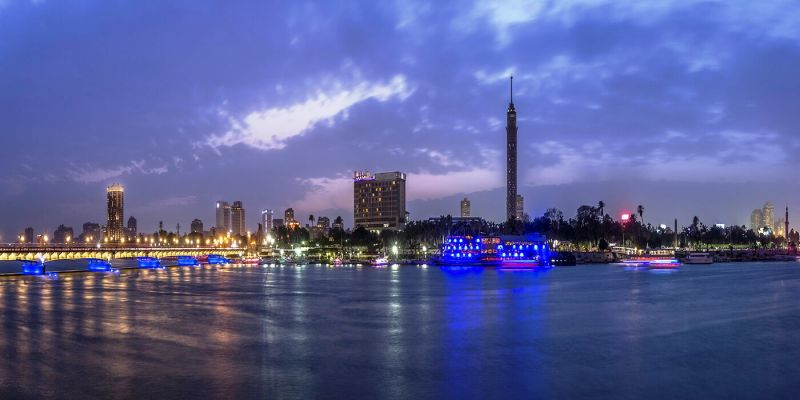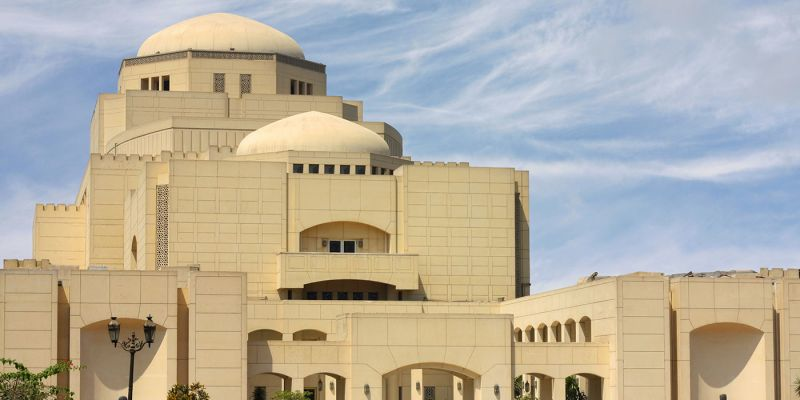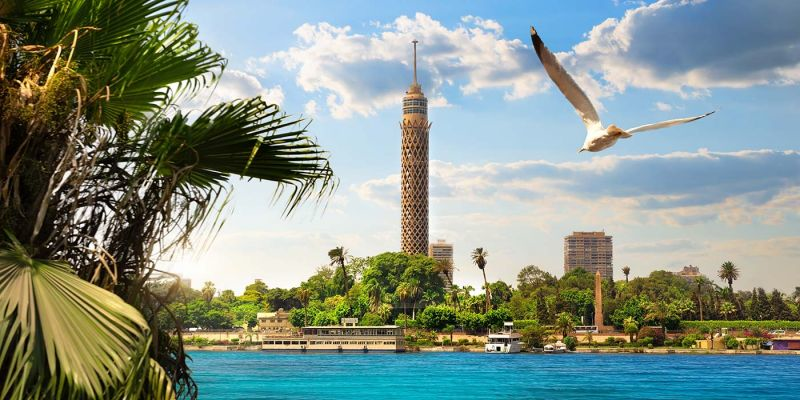History of Zamalek/ Gezira, and who developed it?

Visit Zamalek on the north end of the island to stroll in the quiet, tree-lined streets. In recent years the neighborhood has been more densely developed, but some of the grand villas that covered the island 100 years ago when it was an enclave reserved for diplomats, colonial officials, and Egyptian aristocracy still remain. Zamalek also hosts some of Cairo’s finest restaurants and shops.
Cairo Tower, the Gezira Club, and the new Cairo Opera House dominate the south end of the island. The Gezira Club was originally the British officers club during colonial occupation, but today it is an exclusive club populated by foreigners and the Egyptian elite. Cairo Tower, built-in 1962 by President Gamal Abdel Nasser, offers an impressive panoramic view over Cairo. On a clear day, you can see both the minarets of Cairo’s Citadel to the east and the peaks of the Pyramids in the west. The Opera House is a towering modernist update on Islamic architectural traditions and has a program consisting of opera, ballet, theater, and contemporary music performances.


Customize Your Dream Vacation!
Get in touch with our local experts for an unforgettable journey.
Plan Your Trip

Sequoia—a luxurious outdoor restaurant at the northern point of the island provides delicious Lebanese/Egyptian Mezza, beautiful views of the river, and unmatched ambiance. Review here.
Egypt Pyramids
- Dahshur Pyramids | Egypt Pyramids
- How Were the Pyramids Built?
- The Bent Pyramid at Dahshur
- Khafre Pyramid (Pyramid of Chefren)
- Pyramid of Khufu (Cheops Pyramid)
- Pyramid of Menkaure (Mykerinus Pyramid)
- Djoser Step Pyramid at Saqqara
- Giza Necropolis
- The City of Memphis, Egypt
- Saqqara Step Pyramid Egypt
- The Red Pyramid at Dahshur
ِAncient Egyptian History
- The Middle Kingdom of Ancient Egypt
- Alexander the Great | Egypt History
- Queen Hatshepsut
- King Tutankhamun Facts
- Salah Al-Din Al-Ayyubi
- King Ramses II: Facts, Accomplishments, Life and Death
- Sultan Mohammad Ali
- Amr Ibn Al-Aas
- The Old Kingdom of Ancient Egypt
- The New Kingdom of Ancient Egypt
- Greco-Roman Period
- Early Islamic Period in Egypt
- Mamluk and Ottoman Period
- Egypt in the Modern Era
- Behind the Throne: Exploring the Life and Reign of Queen Cleopatra of Egypt
Cairo Attractions
- Al Aqmar Mosque | Cairo | Egypt
- Sultan Al Mansur Qalawun Mosque
- Al Azhar Mosque
- Mosque of Amr ibn al-As: Egypt’s Oldest Mosque and a Living Chronicle of Faith
- Bab Zuweila
- Museum of Islamic Art
- Sultan Hassan Mosque & Madrasa | Islamic Cairo
- Ahmed Ibn Tulun Mosque
- Bayt Al Suhaymi in Cairo
- Cairo Opera House
- The Coptic Museum in Cairo
- The Egyptian Museum in Cairo
- El Ghorya | Attractions in Cairo Egypt
- Ben Ezra Synagogue | Coptic Cairo
- Khan El Khalili Bazaar
- Old Cairo and Coptic Cairo
- Salah El Din Citadel in Cairo | Egypt
- The Hanging Church | Coptic Cairo
- Al-Muizz Al-Deen Allah Street
- Downtown Cairo
- Zamalek / Gezira
- Islamic Cairo
- Souk Al Khayamiya | Tentmakers Bazaar
Alexandria Attractions
- City of Alexandria
- El Ain El Sokhna | Red Sea Egypt
- El Sharkia Governorate History | Egypt Cities
- The Faiyum Travel Guide | Egypt
- Port Said Travel guide | Egypt
- Marsa Alam Information
- Aswan High Dam | The High Dam of Egypt
- Qaitbay Citadel in Alexandria
- Pompey's Pillar in Alexandria
- Why El Alamein Egypt Became World War II's Most Important Battlefield
- Alexandria Egypt | Pearl of the Mediterranean
- Alexandria Library Egypt | Bibliotheca Alexandria
- Experience the Heart of the Mediterranean: Your Guide to the Best Things to Do in Alexandria, Egypt
- Cairo Travel information | Cairo Egypt
- The Catacombs of Kom el-Shuqafa
- Greco-Roman Museum
- Lighthouse of Alexandria
- Luxor Travel Guide | Luxor City | Egypt
- Montazah Park Alexandria
- Red Sea Egypt | Red Sea Travel Guide
- The Western Desert of Egypt | Egypt Oases
Luxor Attractions
- Luxor Travel Guide
- Luxor Temple Guide: History, Location & What to See in Egypt’s Timeless Riverside Monument
- Colossi of Memnon
- Karnak Temple
- Madinet Habu
- Temple of Hatshepsut
- The Tombs of the Nobles
- Valley of the Kings: A Complete Guide to Egypt’s Royal Afterlife Gateway
- Valley of the Queens
- Deir Al Medinah (Workers’ Village)
- The Ramesseum
Aswan Attractions
Nile Valley
Red Sea and Sinai
Ports of Call
Egyptian Culture and Travel Info
Explore Cairo's museums, starting with the Grand Egyptian Museum (GEM) and then head to the Egyptian Museum.
Enjoy a camel ride at Giza Pyramids for 2 hours during the sun rise or sun set. Mount a camel and ride it through the desert to the base of the Great Pyramid. There are horses if a camel seems a bit intimidating.
Fly from Cairo to Aswan for a 4-day cruise tour on the Nile. Visit Karnak, Luxor Temple, the Valley of the Kings, Hatshepsut Temple, Kom Ombo, Edfu, Philae Temple, and enjoy the beautiful scenery of the Nile Valley
Plan Your Trip!
You Might Also Like

Al Aqmar Mosque was built by al-Ma'mun al-Bata'hi, wazir of the Fatmid Khalif-Amir, in 1125. Click here to know more about Egypt Islamic history through Memphis tours!

Visit Sultan Al Mansur Qalawun Mosque in Islamic Cairo—Marvel at this Mamluk masterpiece and learn about its fascinating historical significance.

Uncover the significance of Al Azhar Mosque, Cairo’s grand mosque and prestigious university—a cornerstone of Islamic heritage and learning.

Journey into Egypt’s past at the Mosque of Amr ibn al-As. Learn its history and explore this cornerstone of Islamic culture in Cairo.

Journey through Old Cairo’s history at Bab Zuweila. Uncover stories, architecture, and secrets of this legendary city gate.

Explore the Museum of Islamic Art, Doha’s cultural gem. Witness stunning collections where the story of Islamic art and history beautifully unfolds.

Although it stands in the shadow of the Citadel, Sultan Hassan’s Madrassa-Mosque still manages to make a strong impression. The building is a massive example of Mamluk architecture, constructed during the 14th century reign of a sultan who was famous for his extravagant spending.

Step into history with Ahmed Ibn Tulun Mosque. Learn about its stunning architecture, captivating past, and importance in Islamic culture.

Discover Bayt Al Suhaymi Cairo—an authentic glimpse into Ottoman life. Visit beit el seheimy for rich architecture, culture, and history.

Discover the history and charm of the Cairo Opera House, Egypt’s hub for music, ballet, and cultural performances. Plan your visit today.

The Coptic Museum lies behind the walls of the famous Roman fortress of Babylon in the ancient district of Cairo (Misr Al-Qadima).

The Egyptian Museum is hard to miss on any tour of Cairo. Opening in 1902, it was purpose-built to house the antiquities of Ancient Egypt.

The complex was a built as a unique, multi-use space. It included the mosque and the mausoleum, but also a sabil that provided free water to the people, administrative space, and a covered market among other things.

Located deep in the winding alleys of Coptic Cairo, Ben Ezra Synagogue is the oldest Jewish temple in Cairo, dating from the 9th century AD.

No trip to Cairo would be complete without a visit to Khan Al-Khalili. The bazaar is loud, crowded, colorful, and exciting—full of all kinds of goods and shiny baubles.

The district of Old Cairo ( Masr al-Qadima in Arabic ) is Located in the south part of the city, on the right bank of the Nile opposite to the Island of Roda. Know More!

Salah El Din (known as Saladin to European historians) overthrew the Fatimid dynasty in 1171 AD, establishing the new Sunni Ayyubid Caliphate.

The most famous site in Coptic Cairo is the Church of the Virgin Mary, better known by its nickname, the Hanging Church. Learn more!

Egyptians refer to Downtown as Wust al-Balad, which can be poetically understood to mean “the heart of the country”. This crowded, bustling district of Cairo certainly lives up to the name.

Gezira is the Arabic word for island, but in Cairo, it is most commonly used to refer to a specific island in the middle of the Nile between Downtown Cairo and the area in Giza known as Dokki.

Islamic Cairo is the historic core of the city. When the Fatimid dynasty conquered Egypt in 969 AD, they constructed a new capital north of the existing city to serve as their administrative center.

Just beyond the southern walls of Fatimid Cairo across the street from Bab Zuweila stands a singular space in modern Cairo.

When the Fatimids took control of Egypt in 969 AD, high taxes and poor governance by the Ikhshidid Abbasidds, who had ruled Egypt since 905 AD, had ravaged the region and its capital, Fustat.






